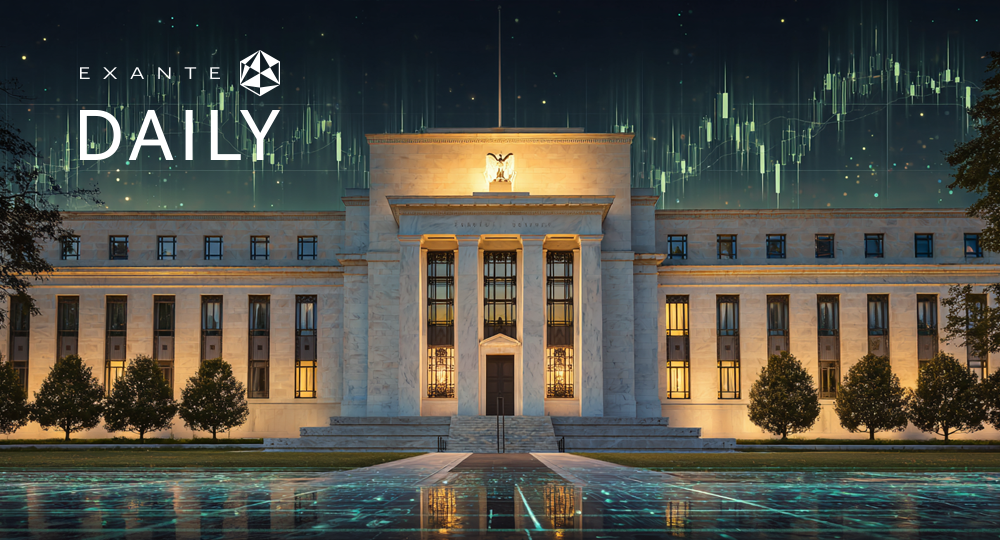
How long will the wave of good news last?

% to a record high of 6,445.76
What to look out for today
Companies reporting on Wednesday, 13th August: Cisco Systems
Key data to move markets today
EU: German and Spanish Harmonised Index of Consumer Prices.
US: Speeches by Richmond Fed President Thomas Barkin, Chicago Fed President Austan Goolsbee, and Atlanta Fed President Raphael Bostic.
US Stock Indices
Dow Jones Industrial Average +1.10%.
Nasdaq 100 +1.33%.
S&P 500 +1.13%, with all of the 11 sectors of the S&P 500 up.
US equities were up following yesterday’s CPI report, which was in line with expectations, and reinforced the idea that the Fed will have room to cut interest rates in September. The S&P 500 and the Nasdaq 100 reached new all-time highs and the Russell 2000 was +2.99%.
The July CPI data, combined with consumer surveys showing moderating inflation expectations and jobs data indicating a slowing momentum in the labour market, provides support to the argument for the Fed to begin cutting interest rates in September, despite inflation, on a y/o/y basis, remaining above its long-term target.
In corporate news, Elon Musk has accused Apple of violating antitrust law by favoring OpenAI in its App Store and stated that his xAI company would ‘take immediate legal action.’
Cava Group lowered its annual sales outlook after a significant slowdown in Q2. The company is facing pressure to maintain its rapid growth as consumers spend less on restaurant meals.
AI startup Perplexity has made a formal offer to acquire Google's Chrome browser for $34.5 billion. This ambitious bid comes amid potential US antitrust proceedings that could require Google to sell the web browser.
According to Bloomberg news, Gildan Activewear is in advanced talks to acquire US underwear maker Hanesbrands, which would be its largest acquisition to date.
Smithfield Foods, the largest pork supplier in the US, raised its full-year profit expectations. This improvement is attributed to a rebound in its hog business, which is offsetting the impact of tariffs.
Cargill's revenue fell to its lowest level in four years. The largest private company in the US continues to restructure in response to declining crop prices and a shrinking American cattle herd.
S&P 500 Best performing sector
Communication Services +1.79%, with Paramount Skydance +8.40%, Take-Two Interactive Software +4.44%, and Warner Bros. Discovery +4.08%.
S&P 500 Worst performing sector
Consumer Staples +0.17%, with Kroger -1.08%, Philip Morris International -1.01%, and McCormick & Company -0.83%.
Mega Caps
Alphabet +1.25%, Amazon +0.08%, Apple +1.09%, Meta Platforms +3.15%, Microsoft +1.40%, Nvidia +0.55%, and Tesla +0.53%.
Information Technology
Best performer: NXP Semiconductors +7.26%.
Worst performer: Tyler Technologies -3.47%.
Materials and Mining
Best performer: Dow +4.02%
Worst performer: Mosaic -4.03%.
European Stock Indicest
CAC 40 +0.71%.
DAX -0.23%.
FTSE 100 +0.20%.
As of 12th August, according to LSEG I/B/E/S data, for the STOXX 600, Q2 2025 earnings are expected to increase 4.8% from Q2 2024. Excluding the Energy sector, earnings are expected to increase 8.5%. Q2 2025 revenue is expected to decrease 1.3% from Q2 2024. Excluding the Energy sector, revenues are expected to increase 0.9%. Of the 237 companies in the STOXX 600 that have reported earnings by 12th August for Q2 2025, 54.0% reported results exceeding analyst estimates. In a typical quarter 54% beat analyst EPS estimates. Of the 305 companies in the STOXX 600 that have reported revenue for Q2 2025, 49.8% reported revenue exceeding analyst estimates. In a typical quarter 58% beat analyst revenue estimates.
Financials is the sector with most companies reporting above estimates at 72%. Financials with a surprise factor of 12.5%, is the sector that beat earnings expectations by the highest surprise factor. In the Basic Materials sector, 76% of companies have reported below estimates, and its earnings surprise factor was the lowest at -10.8%. The STOXX 600 surprise factor is 6.2%, which is above the long-term (since 2012) average surprise factor of 5.8%. The forward four-quarter price-to-earnings ratio (P/E) for the STOXX 600 sits at 14.3x, slightly above the 10-year average of 14.2x.
During the week of 18th August, 18 companies are scheduled to report Q2 earnings.
Corporate Earnings Reports
Posted on Tuesday, 12th August
- Cardinal Health quarterly revenue +0.5% to $60.159 bn vs. $60.892 bn estimate.
EPS at $2.08 vs. $2.04 estimate.
Jason Hollar, CEO, said, “Fiscal 2025 was a transformative year for Cardinal Health, and we closed the year with momentum, delivering strong fourth quarter results. The broad-based operational strength, with all five of our operating segments growing profit double-digits, reflects the disciplined execution of our strategy and our investments for growth. We enter Fiscal 2026 with confidence, evidenced by our increased financial outlook, as we continue to evolve towards reaching our full potential.” — see report.
Commodities
Gold spot +0.27% to $3,351.36 an ounce.
Silver spot +0.79% to $37.90 an ounce.
West Texas Intermediate -1.36% to $63.11 a barrel.
Brent crude -0.85% to $66.11 a barrel.
Gold prices saw a slight increase on Tuesday on increasing expectations of a September rate cut by the Fed following the release of July inflation data that was in line with expectations. Spot gold rose by +0.27%, reaching $3,351.36 an ounce.
Support for gold was also driven by a weakening US dollar, which makes the metal more affordable for international buyers.
Investors are now shifting their attention to a series of upcoming US economic data releases this week, including the US Producer Price Index (PPI), weekly jobless claims, and retail sales.
Oil prices declined on Tuesday as market focus shifted to the approaching end of the summer driving season in early September, which typically signals a drop in demand.
Brent crude futures fell by 57 cents, or -0.85%, to settle at $66.11 per barrel, while WTI crude futures dropped by 87 cents, or -1.36%, to $63.11.
Both OPEC and the US Energy Information Administration (EIA) have released outlooks that point to higher production this year. However, they both anticipate a decline in US output in 2026, while other global regions are expected to increase their oil and natural gas production.
In its Short-Term Energy Outlook released on Tuesday, the EIA forecast that US crude production will reach a record 13.41 million barrels per day (bpd) in 2025, driven by improved well productivity. This is expected to be followed by a decline in output to 13.28 million bpd in 2026, which would mark the first annual drop for the world's largest producer since 2021.
The EIA also adjusted its price forecast for Brent, the international benchmark, projecting an average of $51 per barrel next year. This is a downward revision from its previous estimate of $58 per barrel, following a decision by OPEC and its members to accelerate their pace of production increases.
OPEC's forecasts for 2026. On Tuesday, OPEC revised its global oil demand forecast for the upcoming year. It also lowered its growth estimate for supply from countries outside of the broader OPEC+ group. The outlook for increased demand, combined with slower supply growth from non-OPEC+ producers, would likely make it easier for OPEC+ to continue its strategy of increasing output to regain market share following several years of production cuts.
In its Monthly Oil Market Report, OPEC projected that global oil demand will rise by 1.38 million barrels per day (bpd) in 2026, an increase of 100,000 bpd from its previous forecast. The organisation maintained its forecast for the current year. OPEC's projections are on the higher end of industry estimates; for example, the International Energy Agency (IEA) anticipates a more gradual energy transition and forecasts a rise of only 700,000 bpd this year.
OPEC also slightly increased its forecast for global economic growth in 2025 to 3.0%. According to the report, “Economic data at the start of the second half of 2025 further confirm the resilience of global growth, despite persistent uncertainties related to US-centred trade tensions and broader geopolitical risks.”
Analysts suggest that a decline in oil prices this year, partly due to OPEC+ output hikes and concerns over US tariffs, has pressured the economics of US shale production. As a result, OPEC's report now projects that US tight oil—a term for shale—output will decline by 100,000 bpd in 2026, reversing its previous outlook for flat year-on-year production.
This revised forecast is based on assumptions of ‘sustained capital discipline, additional drilling and completion efficiency gains, weaker momentum in drilling activities and increased associated gas production in key shale oil regions,’ according to OPEC.
Overall, oil supply from countries outside of OPEC+ is expected to rise by approximately 630,000 bpd in 2026, a decrease from last month's forecast of 730,000 bpd. While the US is still expected to be a key contributor to this growth, OPEC has revised its forecast for total US oil output to an increase of about 130,000 bpd next year, a significant reduction from its January forecast of 510,000 bpd.
The report also noted that in July, OPEC+ crude output increased by 335,000 bpd, falling slightly short of the 411,000 bpd hike stipulated by the group's quota increase for the month.
The IEA is scheduled to release its latest forecasts today.
Note: As of 5 pm EDT 12 August 2025
Currencies
EUR +0.52% to $1.1673.
GBP +0.48% to $1.3497.
Bitcoin +0.85% to $119,863.26.
Ethereum +7.84% to $4,584.18.
The US dollar weakened against the euro on Tuesday following the release of US consumer price data, which showed a moderate increase in July.
According to the Bureau of Labor Statistics, headline CPI rose by 0.2% last month, a slight decrease from the 0.3% gain in June. On an annual basis, the CPI advanced by 2.7%, matching the rate from June. These figures were largely in line with market expectations, which had forecasted a 0.2% monthly increase and a 2.8% year-on-year rise.
The euro reversed earlier losses to trade up +0.52% against the dollar at $1.1673. The dollar also pared its gains against the yen, falling -0.18% to ¥147.84.
Sterling strengthened against the dollar, rising +0.48% to $1.3497. This occurred despite data showing a continued, though slower, weakening of the British labour market. However, strong wage growth persisted, which reinforces the BoE's cautious stance on interest rate cuts.
The pound also extended its gains against the euro for a fourth consecutive session, with the euro down -0.24% at 86.24 pence, its lowest level since late July.
Market participants are now pricing in a roughly 50% chance of an additional rate cut by the BoE this year.
Fixed Income
US 10-year Treasury +0.5 basis points to 4.294%.
German 10-year bund +4.7 basis points to 2.747%.
UK 10-year gilt +6.1 basis points to 4.629%.
The two-year Treasury yield dropped on Tuesday after July's US consumer price inflation report came in largely as expected, showing limited pressure from tariffs. This boosted market expectations that the Fed will cut interest rates in September.
This shift in market sentiment follows the NFP jobs data for July, which revealed that employers added fewer jobs than anticipated. Furthermore, job gains for May and June were also revised significantly downward, leading investors to increase their bets on a September rate cut that may also potentially be a larger rate cut.
The yield on the 2-year note fell by -4.0 bps to 3.743%. In contrast, the 10-year note yield was +0.5 bps to 4.294% and the 30-year yield was +3.0 bps to 4.884%.
Fed funds futures traders are now pricing in a 93.4% probability of a rate cut in September, up from 92.9% last week and from 85.9% Monday, according to CME Group's FedWatch Tool. Traders are currently anticipating 60.3 bps of cuts by year-end, higher than the 58.1 bps expected last week.
Across the Atlantic, German 30-year bond yields reached their highest level since 2011 on Tuesday, as investors focused on the prospect of a significant increase in the country's fiscal spending. This anticipated spending is aimed at stimulating economic growth and expanding defence capabilities.
The yield on Germany's 30-year government bond climbed to 3.299%, a +7.3 bps increase, after touching a session high of 3.310%.
For much of the session, eurozone borrowing costs had remained stable following the expected extension of the trade truce between the US and China. However, other German yields also rose, with the policy-sensitive two-year yield increasing by +0.2 bps to 1.979% and the 10-year yield rising +4.7 bps to 2.747%.
Italy's 10-year government bond yield was +3.8 bps to 3.531%. The spread between Italian and German 10-year yields narrowed to 78.4 bps, a 0.9 basis point decrease from the previous session and its lowest level in over 15 years.
Note: As of 5 pm EDT 12 August 2025
Global Macro Updates
July CPI report. The July Consumer Price Index (CPI) report presented a mixed picture, with a re-acceleration in services inflation partially offset by a moderation in goods inflation. Core CPI—which excludes food and energy prices—rose 0.3% m/o/m, aligning with expectations but slightly higher than June's 0.2% increase, pushing the annualised rate to 3.1%. Headline CPI increased 0.2% for the month, meeting forecasts and cooling from the 0.3% rise in June. The primary driver of the monthly increase was a 0.2% rise in the shelter index.
Among specific categories, the impact of tariffs was evident but limited. Apparel prices saw a modest 0.1% m/o/m increase, down from 0.4% in June. Used vehicles, however, rose 0.5% after a 0.7% decrease the previous month. Prices for home furnishings and supplies increased 0.7% m/o/m, a slight slowdown from June’s 1.0%, while appliances saw a decline of -0.9% after a 1.9% jump in June. Overall, core goods inflation remained stable at 0.2% m/o/m, but core services inflation accelerated to 0.4% from 0.3% in June.
Analysts generally view the report as supportive of a September rate cut, with the probability of a cut rising from 80% to 92% following the release. However, some have voiced concern over the re-acceleration in services inflation and the potential for a delayed pickup in core goods prices due to tariffs. Recent Fedspeak focus on labour market data, following a series of weak readings, also remains a key factor in upcoming policy decisions.
UK employment falls for the sixth month; persistent wage growth continues. According to preliminary figures released by the Office for National Statistics (ONS) on Tuesday, UK payroll employment declined for the sixth consecutive month in July, with a decrease of 8,000 jobs. This follows a revised drop of 26,000 jobs in June, which was a smaller decline than the 41,000 previously reported. Despite the continued job losses, separate data showed that wage growth, excluding bonuses, remained steady at 5% in the three months leading up to June. This persistent wage growth highlights the ongoing inflationary pressures facing the economy and poses a challenge for the BoE as it weighs when to next cut interest rates.
Economists noted that the slower pace of job losses in June and July may help to alleviate some of the BoE Monetary Policy Committee's concerns regarding the labour market.
However, the number of job vacancies also fell, decreasing by 44,000 to a total of 718,000. Vacancies dropped in 16 of the 18 industry sectors monitored by the ONS, with the arts, entertainment, and recreation sector experiencing the largest percentage decrease, at 17.6%, from the previous quarter.
This sustained sluggishness in the jobs market increases the pressure on Chancellor Rachel Reeves as she prepares for another difficult autumn Budget. Businesses have attributed the recent pullback in hiring to tax increases announced in her October Budget. A £25 billion rise in National Insurance contributions, along with an increase in the minimum wage, took effect in April. The low-paying hospitality sector, in particular, has seen the fastest rate of job shedding since the October Budget.
While every effort has been made to verify the accuracy of this information, EXT Ltd. (hereafter known as “EXANTE”) cannot accept any responsibility or liability for reliance by any person on this publication or any of the information, opinions, or conclusions contained in this publication. The findings and views expressed in this publication do not necessarily reflect the views of EXANTE. Any action taken upon the information contained in this publication is strictly at your own risk. EXANTE will not be liable for any loss or damage in connection with this publication.
本文提供给您仅供信息参考之用,不应被视为认购或销售此处提及任何投资或相关服务的优惠招揽或游说。金融工具交易存在重大亏损风险,未必适合所有投资者。过往表现并非未来业绩的可靠指标。




